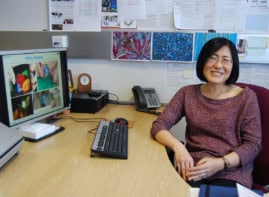
A light-emitting diode (LED) that emits more light energy than it consumes in electrical energy has been unveiled by researchers in the US. The device – which has a conventional efficiency of greater than 200% – behaves as a kind of optical heat pump that converts lattice vibrations into infrared photons, cooling its surroundings in the process. The possibility of such a device was first predicted in 1957, but a practical version had proved impossible to create until now. Potential applications of the phenomenon include energy-efficient lighting and cryogenic refrigeration.
The energy of photons emitted by an LED is dictated by the band gap of the semiconductor used – the energy required to make an electron–hole pair. When an electron and hole recombine in a radiative process, a photon carries away the extra energy. The voltage across the LED creates the electron–hole pairs but its value does not affect the photon energy, since the semiconductor’s band gap is a permanent feature of the material.
However, it is possible for the individual emitted photons to have energies that are different to the band gap. The vast majority of electron–hole recombinations actually result in the production of heat, which is absorbed by the semiconductor in the form of quantized lattice vibrations called phonons. These vibrations create a heat reservoir that can then boost the energy of photons produced by radiative recombination. In 1957 Jan Tauc at the Institute of Technical Physics in Prague pointed out that, since this provided a mechanism for radiation to remove heat from a semiconductor lattice, there was no barrier in principle to an LED being more than 100% efficient, in which case it would actually cool its surroundings.
Obeys the second law
At first glance this conversion of waste heat to useful photons could appear to violate fundamental laws of thermodynamics, but lead researcher Parthiban Santhanam of the Massachusetts Institute of Technology explains that the process is perfectly consistent with the second law of thermodynamics. “The most counterintuitive aspect of this result is that we don’t typically think of light as being a form of heat. Usually we ignore the entropy and think of light as work,” he explains. “If the photons didn’t have entropy (i.e. if they were a form of work, rather than heat), this would break the second law. Instead, the entropy shows up in the outgoing photons, so the second law is satisfied.”
Despite the soundness of the physics, over the past five decades nobody had managed to demonstrate an LED actually cooling its surroundings. One way researchers tried to maximize the number of photons produced was to increase the bias voltage across the LED, but this also increases the heat produced through non-radiative recombinations.
So, Santhanam and colleagues did the exact opposite and reduced the bias voltage to just 70 µV. They also heated the LED to 135 °C to provide more lattice heat. In this regime, less than 0.1% of the electrons passing through the LED produced a photon. However, when the researchers measured the minute power of the infrared radiation produced by the LED, they measured 70 pW of power being emitted by the LED while only 30 pW was being consumed, an efficiency of more than 200%. This happens because as the voltage approaches zero, both light output and power dissipation also vanish. However, the power dissipated is proportional to the square of current, whereas light output is proportional to the current – halving the bias voltage therefore doubles the efficiency.
Important breakthrough
One possible application of the effect is a refrigeration device that removes heat in the form of light. As an expert in this field, Jukka Tulkki of Aalto University in Finland, told physicsworld.com, “I think this is a historically important breakthrough…that could eventually lead to more useful and technologically relevant applications.” However, he cautions that the cooling power of this particular device is extremely low and not great enough for any practical applications.
Santhanam, meanwhile, believes the principle may find applications in fields other than refrigeration. “My personal opinion is that it’s more likely to be useful as a light source,” he says. “Refrigerators are mostly useful when they are high power. Light sources, however, are used in all kinds of ways. In particular, light sources used for spectroscopy and communication don’t necessarily need to be very bright. They just need to be bright enough to be clearly distinguishable from some background noise.”
The research is published in Physical Review Letters.



